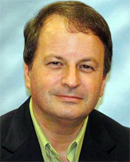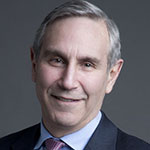The Society of Professional Journalists, asked if the 16-page undercover report on the Starkey private service school in the January Harper’s was “ethical,” has responded with an answer that tosses the question into the laps of our readers.
Kevin Smith, SPJ ethics chair and deputy director of the Kiplinger Program in Public Affairs Journalism, Ohio State University, said that while undercover reporting is to be avoided, it is O.K. if revealing one’s identity would thwart coverage or if the story involved “is of vital public interest.”
 Smith |
“The public is the ultimate arbiters and they can judge if Harper’s work was vital information of public interest and if they could have gleaned much of their work without lying about their resumes and identities,” he added.
All’s Fair in Love, War, PR & Journalism
We think that although this was a “black op,” writer John P. Davidson was justified in going under cover because he could not have obtained the “off-the-cuff” morsels of info that he got if he walked around with a mike, camera and hat with “Press” on it.
For instance, we think it’s true the in many cases any written agreements will be disregarded by employers. Either do what you’re told or leave.
Looking an owner or “principal” in the eye may be your last act. Basically, they don’t even want to see you. Only a few on a staff of 50 may actually have contact with the owners. A new servant who said hello to one of the owners in the morning was gone by nightfall. Also, never speak the name of a “principal” to anyone.
Davidson quoted George Bernard Shaw on servants as saying that when they are “treated like human beings it is not worthwhile to keep them.”
 Davidson |
Any employee or contractor suspected of compromising this privacy will have a brief career.
Super Rich Are Major Factor in Adv./PR
Large swaths of the advertising/PR world show the influence of the super rich. The heads of Omnicom and WPP Group are worth in the hundreds of millions. Conglomerate ownership has had a major impact on the lifestyles of PR and ad people since their acquisition of so many agencies starting in the 1980s. WPP employs 116,000, OMC 71,000, Publicis 59,000, and IPG 43,000. Their agencies are not allowed to take part in advertising or PR industry rankings.
Creatives and account people on Madison ave. in the 1960s and 70s, as well as reporters, were welcome in the clubs, restaurants and country clubs of their bosses. Some 25 PR groups flourished, providing intellectual stimulation. The New York chapter of PR Society of America had a monthly lunch in the Waldorf-Astoria for more than 200. Employers encouraged the building of press ties by providing substantial expense accounts for their PR people.
Just about all the PR groups have vanished. Press/PR relationships are at a minimum. There were no 2013 holiday PR parties at all in New York when there used to be dozens hosted by corporations as well as PR groups. One was attempted--by PRSA/NY--but was cancelled due to low signup.
Cafeterias Replace Restaurants
A visible sign of the growing rich/poor divide in New York is the closing of a half-dozen sit-down restaurants in our area of 39-40th sts. and Madison ave. They have been replaced by cafeterias that have some seating but most customers just “brown bag” it back to their desks.
The steakhouse Benjamin opened in the previous Chemical Club and Overseas Press Club bldg. on 41st st. A steak is $45 and everything else including salad, potatoes and vegetables are extra. Dinner for two would be about $250.
The Williams Club on 39th st., which allowed us as a member for more than 10 years, gave up its historic building because not enough grads could afford the $1,500 dues.
It is now two restaurants, “The Peacock” on the first floor, which is “more refined,” and “The Shakespeare” downstairs, which has lower prices.
As previously noted, apartment prices in New York have skyrocketed because of the influx of buyers from throughout the world who consider New York real estate a safer investment than stocks, gold or something in their own countries.
What Is “Ethical?”
SPJ says journalists and others should study the Harper’s article and decide for themselves if Harper’s and Davidson were unethical.
Breaking a written contract is unethical but apparently employers can do that with impunity. So should reporters be bound by ethical considerations when their story subjects are not?
The PR Society last year withheld IRS Form 990 from the press and members until after the Assembly Oct. 26. There was no discussion of the $61,000 bonus given to Bill Murray, who got boosted from COO to CEO at the same meeting although 2012 revenues of $11,083,420 were less than 2006 revenues, the year before he arrived. No explanation could be obtained for the bonus.
We sought the 990, which has the pay packages of the top six staffers, since last May 15 when this form was initially due. All such requests were ignored until a hard copy landed on our desk in early November. It was stamped “Draft” on every page and had no date on it.
Vice president of PR Stephanie Cegielski was pressed for a copy of the actual filing. When a hard copy came, it also lacked a date. The Society obviously did not want anyone to know when the form was filed with the IRS -- July 16, 2013. Cegielski says the date on the form on GuideStar is the date on a “draft” filing. She has yet to provide the actual date of the filing (assuming July 16 is not that date).
It does not provide an electronic copy of the 990 to anyone, forcing members and interested parties to wait until GuideStar posts such forms which can be as much as six months from the filing (as was the case with the 2012 filing). Members are told they can come to h.q. to view the 990 or send in a written request for it.
The 990 for 2012 was not posted on GuideStar until January 2014.
Society spending on ethics is almost nil -- $5,290 in 2012, $1,406 in 2011, $2,619 in 2010 and $2,891 in 2009.


 Helga Ying, who is in charge of International AIDS Society’s offices in San Francisco and Oakland, is moving to Edelman as global and US chair of Purpose.
Helga Ying, who is in charge of International AIDS Society’s offices in San Francisco and Oakland, is moving to Edelman as global and US chair of Purpose.  Emmanuel Tchividijian, who was senior VP/chief ethics officer at Ruder Finn in a 20-year stint, has established
Emmanuel Tchividijian, who was senior VP/chief ethics officer at Ruder Finn in a 20-year stint, has established  Every profession needs codes of conduct to help ensure the credible performance of its members. The public relations profession has several codes aimed at building and sustaining positive behavior but none of them addresses how practitioners must write for PR and related business purposes. (3 reader comments)
Every profession needs codes of conduct to help ensure the credible performance of its members. The public relations profession has several codes aimed at building and sustaining positive behavior but none of them addresses how practitioners must write for PR and related business purposes. (3 reader comments) Workplace diversity Issues, ranging from race to gender, have long been high profile threats to the brand. Ageism has been the exception - until now. (2 reader comments)
Workplace diversity Issues, ranging from race to gender, have long been high profile threats to the brand. Ageism has been the exception - until now. (2 reader comments) There's a battle for truth, in which people no longer share common facts and are unable to have a rational debate, Richard Edelman said during his speech at USC Annenberg School of Communication and Journalism on April 12. (1 reader comment)
There's a battle for truth, in which people no longer share common facts and are unable to have a rational debate, Richard Edelman said during his speech at USC Annenberg School of Communication and Journalism on April 12. (1 reader comment)


 Have a comment? Send it to
Have a comment? Send it to 
No comments have been submitted for this story yet.